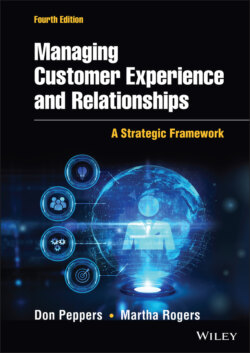Читать книгу Managing Customer Experience and Relationships - Don Peppers - Страница 31
Characteristics of a Genuine Business Relationship
ОглавлениеMutual
Interactive
Iterative
Provides ongoing benefit to both parties
Requires a change in behavior for both parties
Unique
Requires—and produces—trust
Relationships will result in a change in behavior by both parties—the enterprise and the customer—in order to continue. After all, what drives the ongoing benefit of a relationship is not only its context—its history of interactions, developed over time—but also the fact that each party's current and future actions appropriately reflect that historical context. This is an important characteristic to note separately, because companies sometimes mistakenly believe that interactions with customers need only involve routine, outbound communications, delivered the same way to every customer. But unless the enterprise's actions toward a particular customer are somehow tailored to reflect that customer's own input, there will be no ongoing benefit for the customer, and as a result, the customer might not elect to continue the relationship.
Yet another characteristic of a relationship, so obvious it might not seem worth mentioning, is uniqueness. Every relationship is different. Relationships are constituted with individuals, not with populations. As a result, an enterprise that seeks to engage its customers in relationships must be prepared to participate in different interactions, remember different histories, and engage in different behaviors toward different customers. You will not have the same relationship with your waitperson at a restaurant as you do with your business mentor.
Finally, the ultimate requirement and product of a successful, continuing relationship is trust. Trust is a quality worth a book all by itself,9 but fundamentally what we are talking about is the commonsense proposition that if customers develop a relationship with an enterprise, they tend more and more to trust the enterprise to act in their own interest. Trust, and affection, and satisfaction are all related feelings on the part of a customer toward a company with which they have a relationship. They constitute the more emotional elements of a relationship, but for an enterprise to acknowledge and use these elements profitably, it must be able to reconcile its own culture and behavior with the requirement of generating and sustaining the trust of a customer. (For more on this issue, see Chapters 3 and 8.)
Over 20 years ago, business professors Jag Sheth and Atul Parvatiyar predicted that companies are “likely to undertake efforts to institutionalize the relationship with consumers—that is, to create a corporate bonding instead of a bonding between a frontline salesperson and consumer alone.”10
Customer orientation is powerful in theory but, some say, troubled in practice. In some industries, customer satisfaction rates in the United States fall, while complaints, boycotts, and other consumer discontent rise, fueled in magnitude and velocity by social media. Some say there has been a decline in the fundamentals of relationship building among enterprise executives who are more concerned with increasing quarterly profits for their own sake than establishing closer ties to profitable customers. Every aspect of managing customer relationships and experiences is affected by the firm's understanding of relationships in general. Enterprises must fully comprehend the basic foundations of relationships, and the basic principles of the Learning Relationship in particular, before embarking on a customer relationship or customer experience initiative.
Views on business relationships vary, but all provide a relevant perspective to building a relationship framework. We acknowledge that a company may attempt to build a relationship with a customer that the customer has no emotional interest in. By learning from a customer, or a small group of customers with similar needs and behaviors, the company may be able to offer the right product at the right time and provide convenience to a customer who may not be emotionally attached to the product or company but does more and more business with it because it's easier to continue with the current provider than to switch. In many other cases, of course, the relationship is specifically enjoyed by the customer, at the extreme by the Harley-Davidson customer who tattoos the company's brand on their bicep.
We have discussed the foundation of relationship theory and the benefits of getting, keeping, and growing customers. So far, the discussion has included concepts that foster an often-emotional involvement between the customer and the enterprise. The Learning Relationship is a highly personal experience for the customer that ensures that it is always in the customer's self-interest to remain with the enterprise with which they first developed the relationship. We believe this may go beyond a customer's emotional attachment or favoritism for any enterprise; it may also be derived from some sense of obligation. However, many scholars believe that by establishing a Learning Relationship, the customer-focused enterprise increases customer retention by making loyalty more beneficial for the customer than non-loyalty. Others believe that the relationship exists even if a customer is not aware of it and only benefits from a better customer experience. See Jim Barnes for more views on this subject.11
